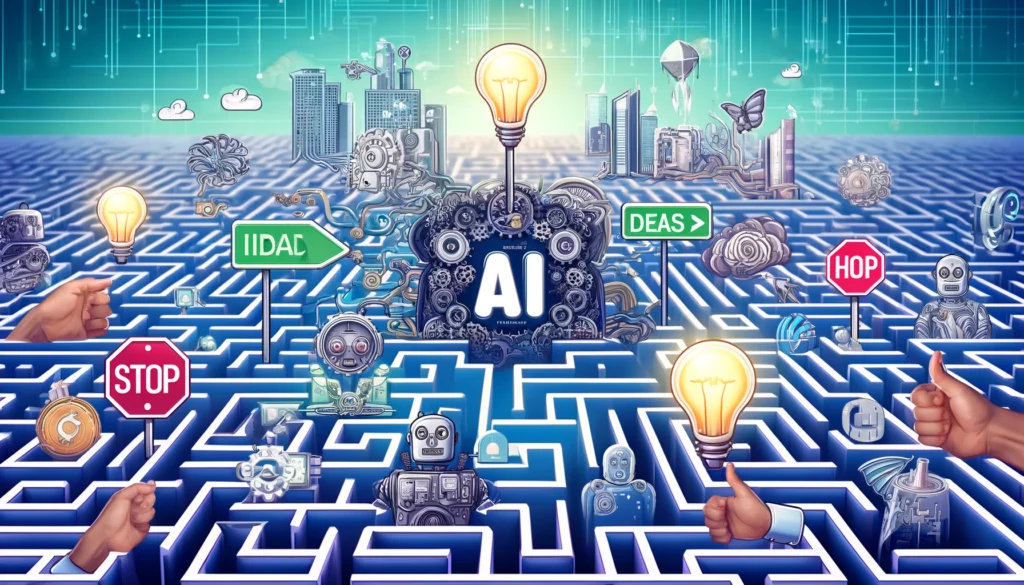Artificial Intelligence (AI) has undoubtedly transformed various sectors, from healthcare to finance, with its promise of automating tasks, enhancing decision-making, and fostering innovation. However, amidst the excitement and potential, there lies a growing tendency to overhype AI, positioning it as a panacea for all business problems. This article explores the exaggeration of AI, illustrating how it is not a magical solution but rather a powerful tool that, when used correctly, can significantly enhance ideas and creativity.
I cringed when I saw a video on LinkedIn addressing the Total Addressable Market (TAM) of AI. Since when did AI become an addressable market? AI is a technology, not a market. This conflation exemplifies how AI has become a buzzword, often misused to attract attention and investment without a clear understanding of its true nature.

The Buzzword Phenomenon
AI has become a buzzword, often misused to attract attention and investment. Companies across industries tout their AI capabilities, sometimes without a clear understanding of what AI truly entails or how it should be applied. This has led to inflated expectations and, in some cases, significant disappointments.
AI Failures: Learning from Missteps
Several high-profile cases highlight the pitfalls of misusing AI. Here are a few examples where the implementation of AI went awry:
- IBM Watson for Oncology: IBM’s Watson for Oncology was heralded as a revolution in cancer treatment, promising to assist doctors by providing evidence-based treatment recommendations. However, it faced criticism for providing unsafe and incorrect suggestions. The main issue was the over-reliance on curated data and limited real-world application testing. This case underscores the dangers of overpromising AI capabilities without rigorous validation and testing.
- Microsoft Tay: Microsoft’s AI chatbot, Tay, was designed to engage with people on Twitter and learn from interactions. Unfortunately, Tay was quickly corrupted by users who taught it to tweet inappropriate and offensive content. This incident demonstrated the vulnerability of AI systems to malicious inputs and the importance of robust safeguards and ethical considerations in AI deployment.
- Uber’s Self-Driving Car: In 2018, an Uber self-driving car struck and killed a pedestrian in Arizona. The AI system failed to recognize the pedestrian correctly, leading to a tragic accident. This highlighted the significant gap between AI’s perceived capabilities and its real-world performance, especially in critical applications like autonomous driving.
AI as an Enhancer: Success Stories
While there are notable failures, AI has also played a crucial role in enhancing ideas and driving success. Here are examples where AI was effectively leveraged:
- Netflix’s Recommendation Engine: Netflix uses AI to analyze viewing patterns and preferences, providing personalized recommendations to its users. This has significantly enhanced user engagement and satisfaction, contributing to Netflix’s success. By harnessing AI, Netflix can keep its content relevant and appealing, demonstrating how AI can enhance customer experience when used appropriately.
- DeepMind’s AlphaFold: DeepMind, a subsidiary of Alphabet, developed AlphaFold, an AI system capable of predicting protein structures with remarkable accuracy. This breakthrough has profound implications for biology and medicine, potentially accelerating drug discovery and understanding diseases. AlphaFold showcases AI’s potential to solve complex scientific problems, enhancing human knowledge and innovation.
- Grammarly: Grammarly utilizes AI to assist with writing by providing grammar and style suggestions. It enhances the writing process for millions of users, from students to professionals, by improving clarity and coherence. Grammarly’s success illustrates how AI can be a valuable tool for enhancing creativity and productivity, rather than replacing human effort.
The Balanced Perspective
The dichotomy between AI’s failures and successes underscores the need for a balanced perspective. AI should not be seen as a catch-all solution but as a powerful tool that, when integrated thoughtfully and ethically, can enhance ideas and drive innovation. Companies must approach AI with realistic expectations, investing in proper research, development, and ethical considerations to harness its true potential.
Conclusion
AI, while a transformative technology, is not a silver bullet for every problem. Its overhyped narrative can lead to unrealistic expectations and significant setbacks. However, when used correctly, AI can enhance creativity, improve decision-making, and solve complex problems. By learning from past mistakes and leveraging AI’s strengths, we can navigate the buzzword landscape and unlock its genuine potential to drive meaningful progress.